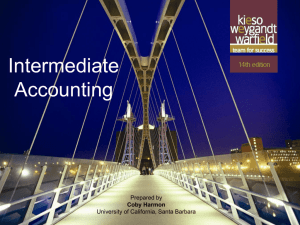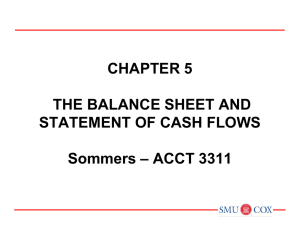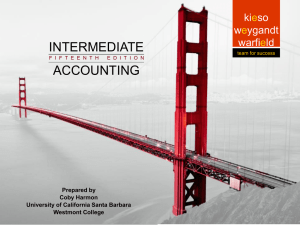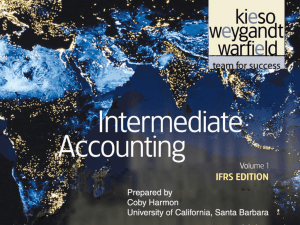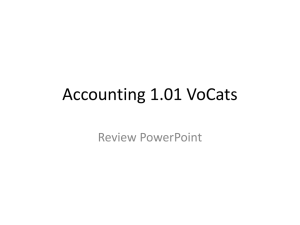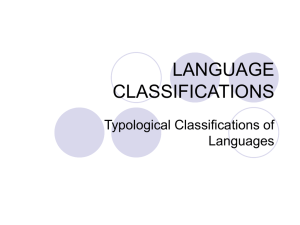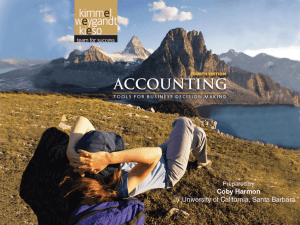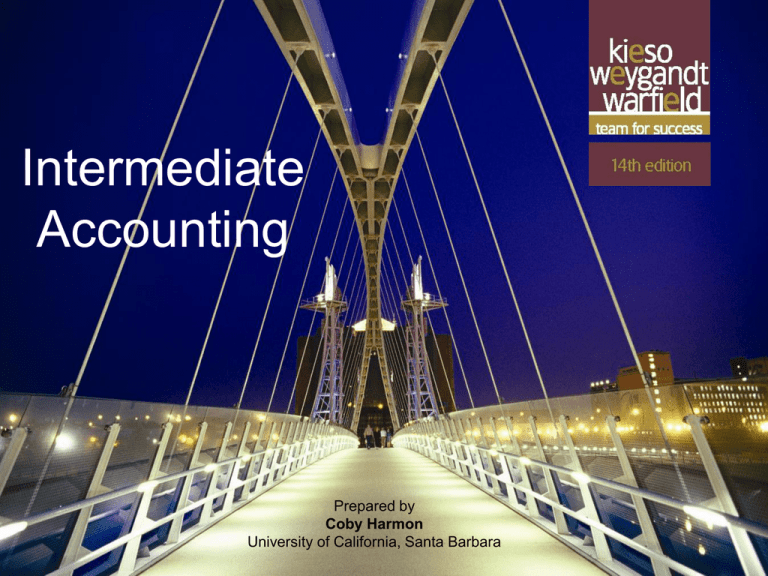
Intermediate
Accounting
5-1
Prepared by
Coby Harmon
University of California, Santa Barbara
5
Balance Sheet and
Statement of Cash Flows
Intermediate Accounting
14th Edition
Kieso, Weygandt, and Warfield
5-2
Learning Objectives
5-3
1.
Explain the uses and limitations of a balance sheet.
2.
Identify the major classifications of the balance sheet.
3.
Prepare a classified balance sheet using the report and account
formats.
4.
Indicate the purpose of the statement of cash flows.
5.
Identify the content of the statement of cash flows.
6.
Prepare a statement of cash flows.
7.
Understand the usefulness of the statement of cash flows.
8.
Determine which balance sheet information requires supplemental
disclosure.
9.
Describe the major disclosure techniques for the balance sheet.
Balance Sheet and Statement of Cash Flows
Balance Sheet
Statement of Cash
Flows
Usefulness
Purpose
Limitations
Content and format
Classification
Preparation
Usefulness
5-4
Additional
Information
Supplemental
disclosures
Techniques of
disclosure
Balance Sheet
Balance Sheet, also referred to as the statement of
financial position:
1. Reports assets, liabilities, and equity at a specific date.
2. Provides information about resources, obligations to
creditors, and equity in net resources.
3. Helps in predicting amounts, timing, and uncertainty of
future cash flows.
5-5
LO 1 Explain the uses and limitations of a balance sheet.
Balance Sheet
Usefulness of the Balance Sheet
5-6
Computing rates of return.
Evaluating the capital structure.
Assess risk and future cash flows.
Analyze the company’s:
►
Liquidity,
►
Solvency, and
►
Financial flexibility.
LO 1 Explain the uses and limitations of a balance sheet.
Balance Sheet
Limitations of the Balance Sheet
5-7
Most assets and liabilities are reported at historical
cost.
Use of judgments and estimates.
Many items of financial value are omitted.
LO 1 Explain the uses and limitations of a balance sheet.
Balance Sheet
Classification
5-8
LO 2 Identify the major classifications of the balance sheet.
Balance Sheet
Classification
Illustration 5-1
In practice you usually see little departure from these major subdivisions.
5-9
LO 2 Identify the major classifications of the balance sheet.
Classification in the Balance Sheet
Current Assets
Cash and other assets a company expects to convert
into cash, sell, or consume either in one year or in the
operating cycle, whichever is longer.
Illustration 5-2
5-10
LO 2 Identify the major classifications of the balance sheet.
Classification in the Balance Sheet
Review
The correct order to present current assets is
a. Cash, accounts receivable, prepaid items, inventories.
b. Cash, accounts receivable, inventories, prepaid items.
c. Cash, inventories, accounts receivable, prepaid items.
d. Cash, inventories, prepaid items, accounts receivable.
5-11
LO 2 Identify the major classifications of the balance sheet.
Balance Sheet – “Current Assets”
Cash
Generally any monies available “on demand.”
Cash equivalents - short-term highly liquid investments
that mature within three months or less.
Restrictions or commitments must be disclosed.
Illustration 5-3
5-12
LO 2
Balance Sheet – “Current Assets”
Cash
Illustration 5-4
Balance Sheet—Restricted Cash
5-13
LO 2 Identify the major classifications of the balance sheet.
Balance Sheet – “Current Assets”
Short-Term Investments
5-14
Portfolios
Type
Valuation
Classification
Held-toMaturity
Debt
Amortized
Cost
Current or
Noncurrent
Trading
Debt or
Equity
Fair Value
Current
Availablefor-Sale
Debt or
Equity
Fair Value
Current or
Noncurrent
LO 2 Identify the major classifications of the balance sheet.
Balance Sheet – “Current Assets”
Short-Term Investments
Illustration 5-5
Balance Sheet Presentation of
Investments in Securities
5-15
LO 2 Identify the major classifications of the balance sheet.
Balance Sheet – “Current Assets”
Receivables
Major categories of receivables should be shown in the
balance sheet or the related notes.
A company should clearly identify
5-16
Anticipated loss due to uncollectibles.
Amount and nature of any nontrade receivables.
Receivables used as collateral.
LO 2 Identify the major classifications of the balance sheet.
Balance Sheet – “Current Assets”
Receivables
Illustration 5-6
Balance Sheet Presentation
of Receivables
5-17
LO 2 Identify the major classifications of the balance sheet.
Balance Sheet – “Current Assets”
Inventories
Disclose:
►
Basis of valuation (e.g., lower-of-cost-or-market).
►
Cost flow assumption (e.g., FIFO or average cost).
Illustration 5-6
5-18
LO 2
Balance Sheet – “Current Assets”
Prepaid Expenses
Payment of cash, that is recorded as an asset because
service or benefit will be received in the future.
Cash Payment
BEFORE
Expense Recorded
Prepayments often occur in regard to:
5-19
insurance
rent
supplies
taxes
advertising
LO 2 Identify the major classifications of the balance sheet.
Balance Sheet – “Current Assets”
Prepaid Expenses
Illustration 5-9
5-20
LO 2 Identify the major classifications of the balance sheet.
Balance Sheet – “Current Assets”
Current Assets - “Summary”
Cash and other assets
a company expects to
convert into cash,
sell, or
consume
either in one year or in
the operating cycle,
whichever is longer.
5-21
Balance Sheet (in thousands)
Current assets
Cash
$ 285,000
ST Investments
140,000
Accounts receivable
777,000
Inventory
402,000
Prepaid expenses
170,000
Total current assets
1,774,000
Investments:
Invesment in ABC bonds
321,657
Investment in UC Inc.
253,980
LO 2 Identify the major classifications of the balance sheet.
Classification in the Balance Sheet
Non-Current Assets
Long-term Investments
1. Securities (bonds, common stock, or long-term notes).
2. Tangible fixed assets not currently used in operations
(land held for speculation).
3. Special funds (sinking fund, pension fund, or plant
expansion fund.
4. Non-consolidated subsidiaries or affilated companies.
5-22
LO 2 Identify the major classifications of the balance sheet.
Balance Sheet – “Noncurrent Assets”
Long-Term Investments
Portfolios
5-23
Type
Valuation
Classification
Held-toMaturity
Debt
Amortized
Cost
Current or
Noncurrent
Trading
Debt or
Equity
Fair Value
Current
Availablefor-Sale
Debt or
Equity
Fair Value
Current or
Noncurrent
LO 2 Identify the major classifications of the balance sheet.
Balance Sheet – “Noncurrent Assets”
Balance Sheet (in thousands)
Long-Term
Investments
Current assets
Cash
Investments:
Securities
Invesment in ABC bonds
321,657
Investment in UC Inc.
253,980
Notes receivable
150,000
bonds,
stock, and
Land held for speculation
550,000
long-term notes
Sinking fund
225,000
Pension fund
653,798
For marketable securities,
management’s intent
determines current or
noncurrent classification.
5-24
$ 285,000
LO 2
Cash surrender value
Investment in Uncon. Sub.
Total investments
84,321
457,836
2,696,592
Property, Plant, and Equip.
Building
Land
1,375,778
975,000
Balance Sheet – “Noncurrent Assets”
Balance Sheet (in thousands)
Long-Term
Investments
Current assets
Cash
$ 285,000
Investments:
Fixed Assets
Land held for
speculation
Invesment in ABC bonds
321,657
Investment in UC Inc.
253,980
Notes receivable
150,000
Land held for speculation
550,000
Sinking fund
225,000
Pension fund
653,798
Cash surrender value
Investment in Uncon. Sub.
Total investments
84,321
457,836
2,696,592
Property, Plant, and Equip.
Building
5-25
LO 2
Land
1,375,778
975,000
Balance Sheet – “Noncurrent Assets”
Balance Sheet (in thousands)
Long-Term
Investments
Current assets
Cash
$ 285,000
Investments:
Special Funds
Invesment in ABC bonds
321,657
Investment in UC Inc.
253,980
Notes receivable
150,000
Land held for speculation
550,000
Sinking fund
Pensions fund
Sinking fund
225,000
Cash surrender
value of life
insurance
Pension fund
653,798
Cash surrender value
Investment in Uncon. Sub.
Total investments
84,321
457,836
2,696,592
Property, Plant, and Equip.
Building
5-26
LO 2
Land
1,375,778
975,000
Balance Sheet – “Noncurrent Assets”
Balance Sheet (in thousands)
Long-Term
Investments
Current assets
Cash
$ 285,000
Investments:
Nonconsolidated
Subsidiaries or
Affiliated
Companies
Invesment in ABC bonds
321,657
Investment in UC Inc.
253,980
Notes receivable
150,000
Land held for speculation
550,000
Sinking fund
225,000
Pension fund
653,798
Cash surrender value
Investment in Uncon. Sub.
Total investments
457,836
2,696,592
Property, Plant, and Equip.
Building
5-27
84,321
LO 2
Land
1,375,778
975,000
Balance Sheet – “Noncurrent Assets”
Long-Term Investments
Illustration 5-10
Balance Sheet
Presentation of
Long-Term Investments
5-28
LO 2 Identify the major classifications of the balance sheet.
Balance Sheet – “Noncurrent Assets”
Property, Plant, and Equipment
Tangible long-lived assets used in the regular operations
of the business.
Physical property such as land, buildings, machinery,
furniture, tools, and wasting resources (minerals).
With the exception of land, a company either depreciates
(e.g., buildings) or depletes (e.g., oil reserves) these
assets.
5-29
LO 2 Identify the major classifications of the balance sheet.
Balance Sheet – “Noncurrent Assets”
Balance Sheet (in thousands)
Property, Plant, and
Equipment
Tangible assets used
in the regular
operations of the
business.
5-30
Current assets
Cash
Total investments
Property, Plant, and Equip.
Building
Land
Machinery and equipment
Capital leases
Leasehold improvements
Accumulated depreciation
Total PP&E
Intangibles
Goodwill
Patents
Trademarks
$ 285,000
2,696,592
1,375,778
975,000
234,958
384,650
175,000
(975,000)
2,170,386
3,000,000
177,000
40,000
LO 2 Identify the major classifications of the balance sheet.
Balance Sheet – “Noncurrent Assets”
Illustration 5-11
Balance Sheet Presentation of
Property, Plant, and Equipment
5-31
LO 2 Identify the major classifications of the balance sheet.
Balance Sheet – “Noncurrent Assets”
Balance Sheet (in thousands)
Intangibles
Lack physical substance
and are not financial
instruments.
5-32
Limited life
intangibles amortized.
Indefinite-life
intangibles tested for
impairment.
Current assets
Cash
Total PP&E
Intangibles
Goodwill
Patents
Trademark
Franchises
Copyright
Total intangibles
Other assets
Prepaid pension costs
Deferred income tax
Total other
Total Assets
$ 285,000
2,170,386
2,000,000
177,000
40,000
125,000
55,000
2,397,000
133,000
40,000
173,000
$ 9,210,978
LO 2
Balance Sheet – “Noncurrent Assets”
Intangibles (BE5-6): Patrick Corporation adjusted trial balance
contained the following asset accounts at December 31, 2012: Prepaid
Rent $12,000; Goodwill $50,000; Franchise Fees Receivable $2,000;
Franchises $47,000; Patents $33,000; Trademarks $10,000. Prepare
the intangible assets section of the balance sheet.
Intangibles
Goodwill
Franchises
47,000
Patents
33,000
Trademarks
10,000
Total
5-33
$ 50,000
$140,000
LO 2 Identify the major classifications of the balance sheet.
Balance Sheet – “Noncurrent Assets”
Intangible Assets
Illustration 5-12
Balance Sheet
Presentation of
Intangible Assets
5-34
LO 2 Identify the major classifications of the balance sheet.
Balance Sheet – “Noncurrent Assets”
Other Assets
Items vary in practice. Can include:
5-35
Long-term prepaid expenses
Non-current receivables
Assets in special funds
Property held for sale
Restricted cash or securities
LO 2 Identify the major classifications of the balance sheet.
Balance Sheet – “Noncurrent Assets”
Balance Sheet (in thousands)
Other Assets
Current assets
Cash
This section should
include only unusual items
sufficiently different from
assets in the other
categories.
5-36
Total PP&E
Intangibles
Goodwill
Patents
Trademark
Franchises
Copyright
Total intangibles
Other assets
Prepaid pension costs
Deferred income tax
Total other
Total Assets
$ 285,000
2,170,386
2,000,000
177,000
40,000
125,000
55,000
2,397,000
133,000
40,000
173,000
$ 9,210,978
LO 2
Classification in the Balance Sheet
Current Liabilities
“Obligations that a
company reasonably
expects to liquidate either
through the use of current
assets or the creation of
other current liabilities.”
5-37
Balance Sheet (in thousands)
Current liabilities
Notes payable
Accounts payable
Accrued compensation
Unearned revenue
Income tax payable
Current maturities LT debt
Total current liabilities
Long-term liabilities
Long-term debt
Obligations capital lease
Deferred income taxes
Total long-term liabilities
Stockholders' equity
$ 233,450
131,800
43,000
17,000
23,400
121,000
569,650
979,500
345,800
77,909
1,403,209
LO 2 Identify the major classifications of the balance sheet.
Classification in the Balance Sheet
Current Liabilities
Illustration 5-13
Balance Sheet Presentation
of Current Liabilities
5-38
LO 2 Identify the major classifications of the balance sheet.
Classification in the Balance Sheet
Long-Term Liabilities
“Obligations that a
company does not
reasonably expect to
liquidate within the normal
operating cycle.”
All covenants and
restrictions must be
disclosed.
5-39
Balance Sheet (in thousands)
Current liabilities
Notes payable
Accounts payable
Accrued compensation
Unearned revenue
Income tax payable
Current maturities LT debt
Total current liabilities
Long-term liabilities
Long-term debt
Obligations capital lease
Deferred income taxes
Total long-term liabilities
Stockholders' equity
$ 233,450
131,800
43,000
17,000
23,400
121,000
569,650
979,500
345,800
77,909
1,403,209
LO 2 Identify the major classifications of the balance sheet.
Balance Sheet – “Long-Term Liabilities”
Long-Term Liabilities (BE5-9): Included in Adams Company’s
December 31, 2012, trial balance are the following accounts: Accounts
Payable $220,000; Pension Asset/Liability $375,000; Discount on
Bonds Payable $29,000; Unearned Revenue $41,000; Bonds Payable
$400,000; Salaries and Wages Payable $27,000; Interest Payable
$12,000; Income Taxes Payable $29,000. Prepare the long-term
liabilities section of the balance sheet.
Long-term liabilities
Pension Asset/liability
Bonds payable
Discount on bonds payable
Total
5-40
$375,000
400,000
(29,000)
746,000
LO 2 Identify the major classifications of the balance sheet.
Balance Sheet – “Long-Term Liabilities”
Non-Current Liabilities
Illustration 5-14
Balance Sheet Presentation
of Non-Current Liabilities
5-41
LO 2 Identify the major classifications of the balance sheet.
Balance Sheet – “Owner’s Equity”
Owners’ Equity
5-42
LO 2 Identify the major classifications of the balance sheet.
Balance Sheet – “Owner’s Equity”
Owners’ Equity
Illustration 5-15
Balance Sheet Presentation
of Stockholders’ Equity
5-43
LO 2 Identify the major classifications of the balance sheet.
Classification in the Balance Sheet
Account
5-44
Classification
(a) Investment in preferred stock
(a) Current asset/Investment
(b) Treasury stock
(b) Stockholders’ Equity
(c) Common stock
(c) Stockholders’ Equity
(d) Cash dividends payable
(d) Current liability
(e) Accumulated depreciation
(e) Contra-asset
(f) Interest payable
(f) Current liability
(g) Deficit
(g) Stockholders’ Equity
(h) Trading securities
(h) Current asset
(i) Unearned revenue
(i) Current liability
LO 2 Identify the major classifications of the balance sheet.
Balance Sheet Format
Classified Balance Sheet
Account form
Report form
Accounting Trends and Techniques—2009 (New York:
AICPA) indicates that all of the 500 companies surveyed
use either the “report form” (438) or the “account form” (62),
sometimes collectively referred to as the “customary form.”
5-45
LO 3 Prepare a classified balance sheet using the report and account formats.
Balance Sheet Format
Account Form
5-46
Illustration 5-16
LO 3 Prepare a classified balance sheet using the report and account formats.
Balance Sheet
Format
Report Form
Illustration 5-16
5-47
LO 3
Statement of Cash Flows
One of the three basic objectives of financial
reporting is
“assessing the amounts, timing, and
uncertainty of cash flows.”
5-48
LO 4 Indicate the purpose of the statement of cash flows.
Statement of Cash Flows
Purpose of the Statement of Cash Flows
To provide relevant information about the cash receipts
and cash payments of an enterprise during a period.
The statement provides answers to the following
questions:
5-49
1.
Where did the cash come from?
2.
What was the cash used for?
3.
What was the change in the cash balance?
LO 4 Indicate the purpose of the statement of cash flows.
Statement of Cash Flows
Content and Format
Three different activities:
Operating,
Investing,
Financing
Illustration 5-17
Basic Format of Cash
Flow Statement
5-50
LO 5 Identify the content of the statement of cash flows.
Statement of Cash Flows
Content and Format
Operating
Investing
Financing
Cash inflows and
Cash inflows and
Cash inflows and
outflows that
outflows from
outflows from
enter into the
non-current
non-current
determination of
assets.
liabilities and
net income.
equity.
The statement’s value is that it helps users evaluate liquidity, solvency,
and financial flexibility.
5-51
LO 5 Identify the content of the statement of cash flows.
Statement of Cash Flows
Illustration 5-18
5-52
LO 5 Identify the content of the statement of cash flows.
Preparation of the Statement of Cash Flows
Sources of Information
Information obtained from several sources:
(1) comparative balance sheets,
(2) the current income statement, and
(3) selected transaction data.
5-53
LO 6 Prepare a basic statement of cash flows.
Statement of Cash Flows
Statement of Cash Flows: On January 1, 2012, in its first
year of operations, Telemarketing Inc. issued 50,000 shares of
$1 par value common stock for $50,000 cash. The company
rented its office space, furniture, and telecommunications
equipment and performed marketing services throughout the
first year. In June 2012 the company purchased land for
$15,000. Illustration 5-19 shows the company’s comparative
balance sheets at the beginning and end of 2012.
5-54
LO 6 Prepare a basic statement of cash flows.
Statement of Cash Flows
Illustration 5-19
Illustration 5-20
5-55
LO 6
Statement of Cash Flows
Preparing the Statement of Cash Flows
Determine:
1. Cash provided by (or used in) operating activities.
2. Cash provided by or used in investing and financing
activities.
3. Determine the change (increase or decrease) in cash
during the period.
4. Reconcile the change in cash with the beginning and the
ending cash balances.
5-56
LO 6 Prepare a basic statement of cash flows.
Statement of Cash Flows
Illustration 5-19
Illustration 5-20
Cash provided by operating activities
5-57
Illustration 5-21
LO 6 Prepare a basic statement of cash flows.
Illustration 5-19
Illustration 5-20
Statement of
Cash Flows
Next, the company
determines its investing
and financing activities.
Illustration 5-21
5-58
Statement of Cash Flows
Statement of Cash Flows (BE 5-12): Keyser Beverage
Company reported the following items in the most recent year.
Activity
5,000
Operating
Financing
10,000
7,000
Operating
Operating
Purchase of equipment
Depreciation expense
8,000
4,000
Investing
Operating
Issue of notes payable
20,000
Financing
Net income
Dividends paid
Increase in accounts receivable
Increase in accounts payable
$40,000
Required: Compute net cash provided by operating activities.
5-59
LO 6 Prepare a basic statement of cash flows.
Statement of Cash Flows
Statement of Cash Flows (BE 5-12)
Statement of Cash Flow (in thousands)
Operating activities
Net income
Increase in accounts receivable
Increase in accounts payable
Depreciation expense
Cash flow from operations
Investing activities
Purchase of equipment
Financing activities
Proceeds from notes payable
Dividends paid
Cash flow from financing
Increase in cash
5-60
$ 40,000
(10,000)
5,000
40,000
75,000
Noncash credit to
revenues.
Noncash charge to
expenses.
(8,000)
20,000
(5,000)
15,000
$ 82,000
LO 6 Prepare a basic statement of cash flows.
Statement of Cash Flows
Review
In preparing a statement of cash flows, which of the following
transactions would be considered an investing activity?
5-61
a.
Sale of equipment at book value
b.
Sale of merchandise on credit
c.
Declaration of a cash dividend
d.
Issuance of bonds payable at a discount receivable.
LO 6 Prepare a basic statement of cash flows.
Statement of Cash Flows
Significant Noncash Activities
Significant financing and investing activities that do not
affect cash are reported in either a separate schedule at
the bottom of the statement of cash flows or in the notes.
Examples include:
5-62
Issuance of common stock to purchase assets.
Conversion of bonds into common stock.
Issuance of debt to purchase assets.
Exchanges on long-lived assets.
LO 6 Prepare a basic statement of cash flows.
Statement of Cash Flows
Illustration 5-23
Comprehensive
Statement of Cash Flows
5-63
Usefulness of the Statement of Cash Flows
Without cash, a company will not survive.
Cash flow from Operations:
High amount - company able to generate sufficient
cash to pay its bills.
Low amount - company may have to borrow or issue
equity securities to pay bills.
5-64
LO 7 Understand the usefulness of the statement of cash flows.
Usefulness of the Statement of Cash Flows
Financial Liquidity
Current Cash
Debt Coverage
Ratio
Net Cash Provided by
Operating Activities
=
Average Current Liabilities
Ratio indicates whether the company can pay off its current
liabilities from its operations. A ratio near 1:1 is good.
5-65
LO 7 Understand the usefulness of the statement of cash flows.
Usefulness of the Statement of Cash Flows
Financial Liquidity
Cash Debt
Coverage
Ratio
Net Cash Provided by
Operating Activities
=
Average Total Liabilities
This ratio indicates a company’s ability to repay its liabilities
from net cash provided by operating activities, without having
to liquidate the assets employed in its operations.
5-66
LO 7 Understand the usefulness of the statement of cash flows.
Usefulness of the Statement of Cash Flows
Free Cash Flow
Illustration 5-28
The amount of discretionary cash flow a company has for
purchasing additional investments, retiring its debt, purchasing
treasury stock, or simply adding to its liquidity.
5-67
LO 7 Understand the usefulness of the statement of cash flows.
Usefulness of the Statement of Cash Flows
Review
The current cash debt coverage ratio is often used to assess
a. financial flexibility.
b. liquidity.
c. profitability.
d. solvency.
5-68
LO 7 Understand the usefulness of the statement of cash flows.
Supplemental Disclosures
Four types of information that are supplemental to account
titles and amounts presented in the balance sheet:
5-69
LO 8 Determine which balance sheet information
requires supplemental disclosure.
Techniques of Disclosure
5-70
Parenthetical Explanations
Notes
Cross-Reference and Contra Items
Supporting Schedules
Terminology
LO 9 Describe the major disclosure techniques for the balance sheet.
APPENDIX
5A
Ratio Analysis—A Reference
Using Ratios to Analyze Performance
Analysts and other interested parties can gather qualitative
information from financial statements by examining
relationships between items on the statements and identifying
trends in these relationships.
5-71
LO 10 Identify the major types of financial ratios and what they measure.
APPENDIX
5A
Ratio Analysis—A Reference
Using Ratios to Analyze Performance
Illustration 5A-1
A Summary of Financial Ratios
5-72
LO 10 Identify the major types of financial ratios and what they measure.
APPENDIX
5A
Ratio Analysis—A Reference
Using Ratios to Analyze Performance
Illustration 5A-1
A Summary of Financial Ratios
5-73
LO 10 Identify the major types of financial ratios and what they measure.
APPENDIX
5A
Ratio Analysis—A Reference
Using Ratios to Analyze Performance
Illustration 5A-1
A Summary of Financial Ratios
5-74
LO 10 Identify the major types of financial ratios and what they measure.
APPENDIX
5-75
5B
Specimen Financial Statements:
The Procter & Gamble Company
APPENDIX
5-76
5B
Specimen Financial Statements:
The Procter & Gamble Company
APPENDIX
5-77
5B
Specimen Financial Statements:
The Procter & Gamble Company
APPENDIX
5-78
5B
Specimen Financial Statements:
The Procter & Gamble Company
APPENDIX
5-79
5B
Specimen Financial Statements:
The Procter & Gamble Company
APPENDIX
5-80
5B
Specimen Financial Statements:
The Procter & Gamble Company
APPENDIX
5-81
5B
Specimen Financial Statements:
The Procter & Gamble Company
RELEVANT FACTS
5-82
IFRS recommends but does not require the use of the title
“statement of financial position” rather than balance sheet.
IFRS requires a classified statement of financial position except in
very limited situations. IFRS follows the same guidelines as this
textbook for distinguishing between current and noncurrent assets
and liabilities. However under GAAP, public companies must follow
SEC regulations, which require specific line items. In addition,
specific GAAP standards mandate certain forms of reporting this
information.
Under IFRS, current assets are usually listed in the reverse order of
liquidity. For example, under GAAP cash is listed first, but under
IFRS it is listed last.
RELEVANT FACTS
5-83
IFRS has many differences in terminology that you will notice in this
textbook.
Both IFRS and GAAP require disclosures about (1) accounting
policies followed, (2) judgments that management has made in the
process of applying the entity’s accounting policies, and (3) the key
assumptions and estimation uncertainty that could result in a
material adjustment to the carrying amounts of assets and liabilities
within the next financial year. Comparative prior period information
must be presented and financial statements must be prepared
annually.
Use of the term “reserve” is discouraged in GAAP, but there is no
such prohibition in IFRS.
IFRS SELF-TEST QUESTION
Current assets under IFRS are listed generally:
a. by importance.
b. in the reverse order of their expected conversion to cash.
c.
by longevity.
d. alphabetically.
5-84
IFRS SELF-TEST QUESTION
Companies that use IFRS:
a. may report all their assets on the statement of financial position
at fair value.
b. are not allowed to net assets (assets 2 liabilities) on their
statement of financial positions.
c.
may report noncurrent assets before current assets on the
statement of financial position.
d. do not have any guidelines as to what should be reported on the
statement of financial position.
5-85
IFRS SELF-TEST QUESTION
A company has purchased a tract of land and expects to build a
production plant on the land in approximately 5 years. During the 5
years before construction, the land will be idle. Under IFRS, the land
should be reported as:
a. land expense.
b. property, plant, and equipment.
c.
an intangible asset.
d. a long-term investment.
5-86
Copyright
Copyright © 2012 John Wiley & Sons, Inc. All rights reserved.
Reproduction or translation of this work beyond that permitted in
Section 117 of the 1976 United States Copyright Act without the
express written permission of the copyright owner is unlawful.
Request for further information should be addressed to the
Permissions Department, John Wiley & Sons, Inc. The purchaser
may make back-up copies for his/her own use only and not for
distribution or resale. The Publisher assumes no responsibility for
errors, omissions, or damages, caused by the use of these
programs or from the use of the information contained herein.
5-87

